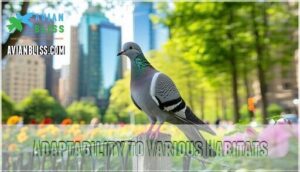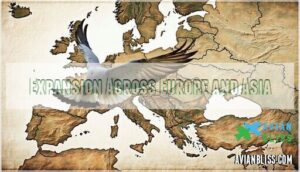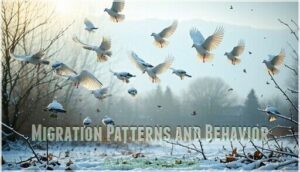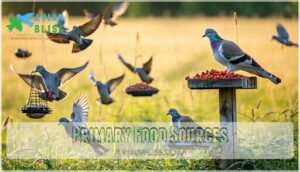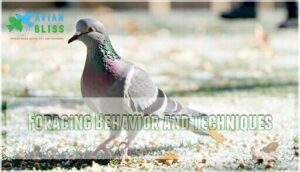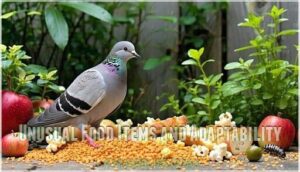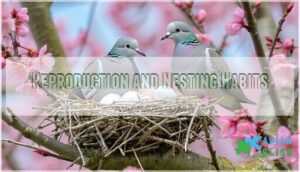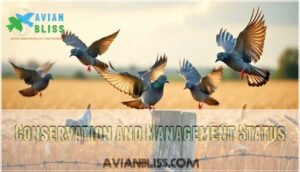This site is supported by our readers. We may earn a commission, at no cost to you, if you purchase through links.
 You’ll find the Eurasian collared dove is a medium-sized dove with distinctive black neck markings that’s become one of Europe’s most successful bird colonizers.
You’ll find the Eurasian collared dove is a medium-sized dove with distinctive black neck markings that’s become one of Europe’s most successful bird colonizers.
These adaptable birds thrive in urban and suburban environments, feeding primarily on seeds, grains, and scraps while displaying remarkable intelligence in their foraging strategies.
They’re prolific breeders with extended nesting seasons, capable of raising multiple broods annually through their efficient parenting system. Originally native to Asia, they’ve dramatically expanded their range across Europe and into North America within just decades.
Their success story reveals fascinating insights about avian adaptability, territorial expansion strategies, and the complex relationship between human development and wildlife populations.
Table Of Contents
- Key Takeaways
- Eurasian Collared Dove Overview
- Habitat and Distribution Patterns
- Diet and Foraging Strategies
- Reproduction and Nesting Habits
- Conservation and Management Status
- Frequently Asked Questions (FAQs)
- Is Eurasian Collared-Dove invasive?
- Is an Eurasian Collared-Dove a pigeon?
- What does it mean when an Eurasian dove visits you?
- What’s the difference between a mourning dove and an Eurasian Collared-Dove?
- Are Eurasian Collared-Doves rare?
- What’s the difference between a Eurasian collared-dove and a mourning dove?
- How did the Eurasian collared-dove get to the US?
- Is a collared-dove an invasive species?
- What are the cultural symbolisms of collared doves?
- How can you care for a collared dove as a pet?
- Conclusion
Key Takeaways
- You’ll identify these birds by their distinctive black collar markings and pale gray-brown plumage, making them easy to spot among other dove species in urban and suburban environments.
- You’ll find they’re incredibly adaptable colonizers who’ve expanded from Asia across Europe and into North America within decades, thriving in cities, suburbs, and agricultural areas through flexible feeding habits.
- You’ll notice their remarkable breeding success comes from extended nesting seasons and shared parenting duties, allowing them to raise multiple broods annually and maintain stable population growth.
- You’ll discover they’re opportunistic feeders who consume seeds, grains, fruits, and even human food scraps, demonstrating exceptional dietary flexibility that supports their rapid territorial expansion.
Eurasian Collared Dove Overview
You’ll recognize the Eurasian Collared Dove by its pale gray-brown plumage and distinctive black collar marking that wraps around the back of its neck.
You’ll spot this medium-sized dove instantly by its signature black collar against soft gray-brown feathers.
This medium-sized dove has become one of Europe’s most successful avian colonizers, expanding its range dramatically over the past century through remarkable adaptability to urban and suburban environments.
Physical Description and Identification
When identifying a Eurasian collared dove, you’ll notice their pale gray-brown plumage with subtle variations across different regions.
This dove species displays distinctive black collar markings on their neck, making bird identification straightforward compared to other dove bird species.
Regional differences in plumage variations help distinguish them from similar species, while feature evolution has created unique hybrid identification challenges in overlapping ranges, particularly affecting complete concepts of species identification.
Size and Weight
You’ll find the Eurasian collared dove measures roughly 12-13 inches in length with a wingspan reaching 18-20 inches.
These dove species typically weigh between 4-6 ounces, showing minimal sexual dimorphism in body proportions. Weight fluctuation occurs seasonally, with birds gaining mass before breeding.
Regional variations exist across their range, though average dimensions remain fairly consistent. This dove bird maintains moderate size compared to other dove facts you might encounter.
Some species, like the smaller Ground Doves, weigh only one ounce, highlighting the significant difference in weight among different dove species, with the Eurasian collared dove being of average weight and having a distinctive appearance.
Plumage and Coloration
You’ll notice the Eurasian Collared Dove’s plumage is beautifully understated, with soft gray-brown tones dominating its feather patterns.
The wings display subtle darker markings, while regional differences in coloration can vary slightly based on local environments.
Plumage development occurs gradually, with juveniles showing less defined patterns, and rare color variations like albinism or leucism, making these bird sightings particularly special for observers documenting dove information and dove facts about this adaptable species throughout its diverse dove habitat range.
Distinctive Features
Beyond the prominent collar markings, you’ll spot several key features when bird watching this invasive species.
Their flight pattern shows broad, rounded wings with distinctive white patches visible during takeoff.
Their robust body shape distinguishes them from smaller doves, while their squared tail feathers display white outer edges.
Their soft vocalizations—a repetitive "coo-COO-coo"—echo through dove habitat as they forage for their diverse dove diet, which includes a variety of foods that make up their diverse dove diet in their dove habitat.
Juvenile Characteristics
You’ll spot juvenile Eurasian Collared Doves by their duller plumage compared to adults, lacking the distinctive black collar that gives these urban birds their name.
Fledgling development shows mottled brown feathers with subtle barring, and parental care extends several weeks as juveniles master learning behaviors essential for survival.
Young birds gradually develop adult coloration over months, with survival rates improving as they adapt to diverse dove diet options available in cities.
Habitat and Distribution Patterns
You’ll discover that Eurasian Collared Doves have become remarkably successful at colonizing diverse environments, from bustling city parks to quiet suburban neighborhoods.
These adaptable birds have expanded their range dramatically across continents, transforming from a relatively localized species into one of the world’s most widespread dove populations, with Eurasian Collared Doves being a key example.
Adaptability to Various Habitats
You’ll discover these birds thrive in surprisingly diverse environments thanks to their remarkable adaptability. Their Urban Adaptation allows them to flourish in cities, while their Climate Tolerance spans temperate to subtropical regions.
Resource Utilization helps them exploit various food sources, and their Nesting Flexibility enables breeding success across habitats.
- Bustling city parks where their distinctive bird sounds echo between buildings
- Quiet suburban gardens offering abundant seeds and nesting sites
- Agricultural areas providing grain fields and scattered trees for roosting
- Semi-arid landscapes where Predator Avoidance strategies prove essential for survival
This adaptability explains why urban birds like Eurasian Collared Doves have become such successful colonizers, with dove population numbers steadily increasing across their range, demonstrating their Climate Tolerance and Urban Adaptation skills.
Expansion Across Europe and Asia
You’ll witness the Eurasian Collared Dove’s remarkable Range Expansion story as this bird migration phenomenon transformed across continents.
Originally confined to Asia, these adaptable birds began their westward journey in the 20th century, demonstrating extraordinary Habitat Adaptation skills while maintaining Genetic Diversity throughout their spread.
| Expansion Timeline | Geographic Coverage |
|---|---|
| 1930s-1950s | Turkey to Balkans |
| 1960s-1980s | Central and Western Europe |
| 1990s-Present | Northern Europe and Asia |
This invasive species conquered Europe through remarkable adaptability, establishing stable dove populations across diverse climates and landscapes throughout Eurasia.
Current Range and Population
You’ll find the Eurasian Collared Dove’s current range spans continents, with populations reaching approximately 85 million individuals globally.
With 85 million Eurasian Collared Doves worldwide, this species has become one of nature’s most successful colonizers.
Range expansion continues across North America, Europe, and Asia, while population density stabilizes in established territories.
Habitat saturation occurs near urban settlements, though invasive impact remains minimal.
Limiting factors include climate extremes, yet this remarkable species demonstrates exceptional adaptability throughout Eurasia.
Their success is attributed to thriving in diverse environments.
Migration Patterns and Behavior
Unlike many bird species, you won’t observe traditional long-distance migrations in Eurasian Collared Doves.
Their range expansion across Eurasia relies on dispersal mechanisms rather than seasonal movements. These behavioral adaptations include short-distance relocations following food availability and breeding opportunities.
Birds use a variety of navigation methods to find new habitats.
Migratory triggers remain minimal, making dove control challenging since populations establish year-round. This bird guide highlights their sedentary nature, essential for bird conservation efforts throughout their geopolitical range.
Diet and Foraging Strategies
You’ll find the Eurasian collared dove’s feeding habits surprisingly opportunistic, as these adaptable birds consume everything from seeds and grains to insects and small invertebrates.
Their flexible foraging strategies include ground-feeding, platform-feeding at feeders, and even scavenging in urban environments, making them remarkably successful colonizers across diverse habitats.
Primary Food Sources
You’ll notice these doves aren’t picky eaters—they’re opportunistic feeders with clear seed preferences for grains like wheat, barley, and corn.
Their grain consumption includes cultivated cereals and wild grass seeds, while fruit intake focuses on berries and small fruits.
Insect consumption occurs mainly during breeding season, providing essential protein.
Supplemental feeding from bird feeders and agricultural areas supports their expanding populations across Eurasia, making dove control challenging in some regions.
Many owners choose a quality dove seed to guarantee proper nutrition, and this is especially important for the health of these birds, considering their expanding populations.
Foraging Behavior and Techniques
You’ll observe these doves employing remarkably efficient Ground Feeding techniques, methodically walking with steady head movements to locate scattered seeds across Eurasia’s diverse landscapes.
Their Seed Preference drives systematic foraging patterns, particularly evident in Urban Foraging environments where Winter Diet adaptations showcase their Foraging Efficiency.
Many enthusiasts find that specialized seed blends can attract these birds.
Dove images from Europe and Asia reveal how these adaptable animals optimize energy expenditure through calculated movements.
Unusual Food Items and Adaptability
These remarkable birds showcase incredible dietary novelty that makes them master adapters in diverse ecosystems.
You’ll discover their urban adaptation skills extend far beyond typical seed consumption, allowing them to thrive across Eurasia despite food scarcity and seasonal changes.
Their invasive diet includes these unusual items:
- Human food scraps – bread crumbs, popcorn, and leftovers from public spaces
- Agricultural spillage – animal feed mixtures and poultry grains from farmsteads
- Ornamental resources – decorative plant seeds and small fruits from suburban gardens
- Protein supplements – insects and caterpillars during harsh conditions.
This flexibility transforms dove images from simple grain-eaters to opportunistic survivors.
Their adaptability supports rapid colonization, alters local biodiversity patterns, and demonstrates how animals can exploit human-modified environments.
Such dietary plasticity reduces competition while enhancing their success as one of nature’s most resourceful species.
Comparison to Other Bird Species
When you’re observing Eurasian Collared Doves, you’ll notice they share feeding territories with several native species, creating fascinating ecological dynamics.
Their dietary habits closely mirror those of Mourning Doves and Ringneck Doves, yet their invasive impact becomes apparent through direct competition for resources across Europe, Asia, and Eurasia.
| Species | Primary Diet | Foraging Location | Ecological Role |
|---|---|---|---|
| Eurasian Collared Dove | Seeds, grains, fruits | Ground, feeders, trees | Invasive competitor |
| Mourning Dove | Seeds, grains | Ground foraging | Native seed disperser |
| Ringneck Dove | Seeds, small fruits | Trees, shrubs | Limited wild presence |
| Rock Pigeon | Grains, human food | Urban areas | Urban adapter |
| Spotted Dove | Seeds, insects | Ground, low vegetation | Regional competitor |
This dietary overlap raises concerns about hybridization risks and biodiversity impacts. While these animals occupy similar niches, Eurasian Collared Doves often outcompete smaller native species due to their aggressive feeding behavior and adaptability to human-modified landscapes throughout their expanding range.
Reproduction and Nesting Habits
You’ll find the Eurasian collared dove’s breeding success comes from its remarkable adaptability and extended nesting season that can span nearly year-round in favorable conditions.
These birds demonstrate fascinating courtship rituals and shared parenting duties that contribute to their impressive population growth across their expanding range.
Mating and Courtship Behaviors
When spring arrives across Eurasia, these doves begin elaborate courtship rituals that showcase remarkable diversity in mate selection strategies.
Males perform distinctive bowing displays while producing rhythmic mating calls, establishing strong pair bonding through synchronized movements.
Their courtship behaviors demonstrate high fidelity rates, with pairs often remaining together across multiple breeding seasons throughout Europe and Asia, making them exceptional among animals with high fidelity rates.
Nest Construction and Location
You’ll find these birds constructing simple yet effective nests across their expanding range throughout Eurasia.
Site selection typically involves horizontal branches or crevices between 10-25 feet high, with pairs showing remarkable adaptability from Europe to Asia.
Their flimsy platform nests measure roughly 6 inches across, built from twigs, roots, and available materials within 2-4 days.
This geological and geopolitical spread demonstrates their construction flexibility, often reusing successful locations multiple times throughout breeding seasons, showcasing their ability to thrive in various environments with remarkable adaptability.
Incubation and Parenting Responsibilities
Both parents share Incubation Period duties equally over 14-16 days across countries in Eurasia, from Europe to Asia.
Their Parental Care includes:
- Taking 4-hour shifts warming eggs
- Alternating Feeding Habits with crop milk production
- Protecting the nest from predators in urban regions.
This teamwork guarantees strong Chick Development and high Fledgling Success rates throughout their range.
They often prioritize safety with strategic nesting sites.
Nesting Season and Frequency
You’ll find Eurasian Collared Doves breeding across multiple continents from Europe to Asia, adapting their nesting frequency to regional conditions.
These resilient birds produce multiple broods annually, with clutch size averaging two eggs per breeding cycle.
Seasonal variations influence breeding intervals, as successful pairs in temperate Eurasia regions maintain higher nesting success rates than those in extreme climates, with regional conditions playing a crucial role.
Conservation and Management Status
You’ll find that Eurasian Collared Doves present a fascinating conservation challenge since they’re actually thriving almost everywhere they’ve established populations.
While most bird species struggle with habitat loss and declining numbers, these adaptable doves have become so successful that wildlife managers often focus on controlling their spread rather than protecting them, which is a unique situation due to their thriving populations.
Current Conservation Status and Threats
Despite classification as "Least Concern" by the IUCN, you’ll find Eurasian Collared Doves face emerging threats across Eurasia that impact both their species and native birds throughout Europe and Asia.
Their rapid spread has led to them being considered an invasive species.
Key conservation concerns include:
- Invasive Impact – Competition with native species for nesting sites and food resources
- Disease Threat – Transmission of Trichomonas gallinae and West Nile Virus to other birds
- Climate Change – Shifting habitat suitability affecting population distribution patterns
- Habitat Loss – Urban development reducing available nesting and foraging areas
Management Strategies and Techniques
Managing Eurasian collared dove populations requires targeted strategies across their range from Europe to Asia.
You’ll find that population control through hunting remains highly effective, with many regions implementing no bag limits to encourage removal of this prolific species.
| Management Approach | Primary Methods |
|---|---|
| Population Control | Hunting programs, trapping, regulated avicides |
| Habitat Modification | Food plot management, water source control |
| Deterrent Methods | Sonic devices, exclusion netting, physical barriers |
| Legal Regulations | Hunting seasons, relocation programs, monitoring requirements |
Research Initiatives and Monitoring Programs
You’ll find thorough research initiatives monitoring Eurasian collared-dove populations across Europe, Asia, and invaded regions through citizen science programs like the Great Backyard Bird Count and Project FeederWatch.
Scientists use tracking technologies and habitat modeling to assess population genetics and impact assessment, with 2-species occupancy models revealing stable mourning dove populations despite collared-dove expansion throughout Eurasia, which involves population genetics and impact assessment.
Importance of Public Awareness and Education
You’ll play a pivotal role in protecting Eurasian Collared Doves by sharing Dove Identification tips with your community, supporting Habitat Preservation efforts in local Eurasian countries, and understanding Diet Impact on population demography.
Conservation Support grows when you educate others about Nesting Awareness, helping maintain healthy populations across Eurasia through informed community action.
Engaging in citizen science projects can further aid conservation efforts.
Frequently Asked Questions (FAQs)
Is Eurasian Collared-Dove invasive?
Since 1982, this species expanded from Florida to Alaska in just four decades.
Eurasian Collared-Doves are considered invasive in North America, spreading at unprecedented speed across the continent.
They’re classified as prohibited invasive species in some states, potentially threatening native dove populations through habitat competition.
Is an Eurasian Collared-Dove a pigeon?
Yes, you’re looking at a member of the pigeon family.
Eurasian Collared-Doves belong to Columbidae, making them true pigeons despite their distinctive "dove" name and sleeker appearance compared to typical city pigeons.
What does it mean when an Eurasian dove visits you?
When a dove visits, it’s like Mother Nature herself is delivering mail!
These appearances carry deep symbolism across cultures—representing peace, spiritual messages, new beginnings, and divine connection in many traditions worldwide.
What’s the difference between a mourning dove and an Eurasian Collared-Dove?
You’ll spot key differences between mourning doves and Eurasian collared doves through size, coloring, and markings.
Eurasian collared doves are larger, grayer, and display a distinctive black collar around their necks that mourning doves lack completely, which is a key distinguishing feature.
Are Eurasian Collared-Doves rare?
Like a rapidly growing wildfire, these birds made their way to Florida by the 1980s.
They then rapidly colonized most of North America.
You’ll find them increasingly common now, not rare at all—they’re expanding aggressively after being introduced.
What’s the difference between a Eurasian collared-dove and a mourning dove?
You’ll notice Eurasian collared-doves are chunkier with square tails, while mourning doves appear slender with pointed tails. Collared-doves sport distinctive black neck stripes that mourning doves lack entirely.
How did the Eurasian collared-dove get to the US?
Like a feathered pioneer blazing new trails, you’ll find these doves hitchhiked to America through human trade routes.
They arrived in the Bahamas during the 1970s, then island-hopped to Florida, spreading rapidly across the continent through their adaptability and breeding success.
Is a collared-dove an invasive species?
Yes, you’ll find the Eurasian collared-dove is considered invasive in North America. It spreads rapidly, competes with native birds for resources, and wasn’t naturally introduced to this continent.
What are the cultural symbolisms of collared doves?
Perched between heaven and earth like gentle messengers, you’ll find collared doves symbolize peace, love, and fidelity across cultures.
They represent divine communication, spiritual guidance, and hope, often appearing in religious art as symbols of the Holy Spirit.
How can you care for a collared dove as a pet?
You’ll need to provide a spacious aviary with perches, nesting boxes, and daily fresh water. Feed them seeds, grains, and occasional fruits while maintaining clean conditions for peak health.
Conclusion
Remarkably resilient and resourceful, the Eurasian collared dove demonstrates nature’s incredible capacity for adaptation and expansion.
You’ve witnessed how this species transformed from Asian origins into a European success story through intelligent foraging, prolific breeding, and remarkable habitat flexibility.
Understanding the Eurasian collared dove’s biology, behavior, and ecological impact helps you appreciate both wildlife adaptability and conservation challenges.
Whether you’re observing these birds in your backyard or studying avian ecology, their story offers valuable insights into species resilience and human-wildlife interactions in our changing world.
- https://en.wikipedia.org/wiki/Eurasian_collared_dove
- https://www.reabic.net/journals/bir/2018/1/BIR_2018_Luna_etal.pdf
- https://peecnature.org/learn/nature-guides/featured-critters/eurasian-collared-dove/
- https://www.bto.org/learn/about-birds/birdfacts/collared-dove
- https://link.springer.com/article/10.1007/s11252-021-01147-x

